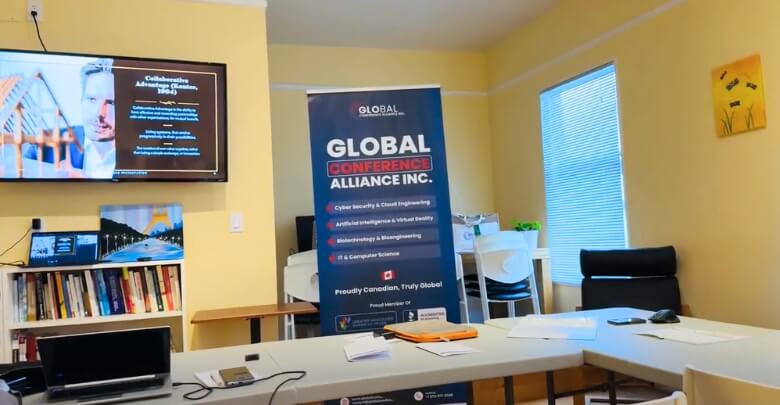Organizing a conference can be a daunting task, especially if you don’t know how to organize a conference checklist? With so many moving parts and details to consider, it is easy to become overwhelmed and lose track of important tasks.
However, with careful planning and organization, anyone can successfully plan and execute a conference that meets their goals and objectives.
To help streamline the process, create a conference checklist. This checklist should include all the necessary steps and tasks to be completed before, during, and after the conference. Using a checklist, you can stay organized, prioritize tasks, and ensure that all aspects of the event are covered.
In this article, we will provide a comprehensive guide on how to organize a conference checklist so that you can feel confident in planning your next event.
Key Takeaways
- Careful planning and organization are crucial for a successful conference
- A checklist can help streamline the planning process and ensure all aspects are covered
- Estimating expenses and negotiating contracts with the venue are important for staying within budget
- Ensuring the safety and well-being of attendees should be a top priority, including implementing safety measures, emergency plans, and accessible facilities.
Set a Budget
Planning a successful conference begins with creating a detailed budget that covers all expenses. This budget should include costs such as venue rental, catering, travel, marketing, and essential equipment like audiovisual setups. Keeping the budget flexible is crucial, as unexpected expenses can arise during the planning process.
Estimating costs accurately is vital, ensuring that funds are allocated properly for each aspect of the event. Popular conference destinations like the United States, the United Kingdom, and conferences in Canada serve as examples of how budgeting impacts event success. By examining these locations, organizers can understand how to balance expenses while maintaining a high-quality experience for attendees.
After setting the budget, selecting an appropriate venue becomes the next important step in the process. The venue should comfortably fit all attendees and offer essential services, such as seating arrangements, food options, and technical support. Choosing the right location ensures a smooth and engaging conference experience.
Choose a Venue
Choosing a venue is a crucial aspect of organizing a successful conference. To make an informed decision, event planners need to determine the venue’s size and location, considering the number of attendees and their accessibility.
Additionally, considering amenities and negotiating contracts and fees are equally important factors in selecting the right venue. Being detail-oriented, organized, and proactive in making these decisions will ensure a positive experience for all attendees.
Determine the Size and Location of the Venue
Optimizing the conference experience starts with selecting an appropriate venue size and location that caters to the needs and preferences of attendees and aligns with the conference’s goals and objectives.
Venue size is crucial since it affects the overall event experience and the attendees’ satisfaction. Choose a venue size that accommodates the expected attendees without being too cramped or spacious.
A venue that is too small can lead to overcrowding, which can be uncomfortable and hinder networking opportunities. On the other hand, a venue that is too large can make the event feel empty, and attendees may feel disconnected from the conference atmosphere.
Location considerations are also essential when choosing a venue. Find a location easily accessible to attendees by public transportation or car. The location should also be safe and have ample parking if necessary.
Additionally, consider the venue’s proximity to hotels, restaurants, and other amenities. Attendees may appreciate being close to these facilities, and it can make their overall experience more enjoyable.
Finding the perfect location may require research and effort, but ensuring attendees have a positive and productive conference experience is worth it.
When considering amenities and accessibility, ensure the chosen venue has the necessary facilities and services to meet the conference’s needs. This can include audiovisual equipment, Wi-Fi, and catering services.
Additionally, consider accessibility for attendees with disabilities and any necessary accommodations that may be required. By taking the time to consider these factors, conference organizers can ensure that the chosen venue is the best fit for their event and creates a positive experience for all attendees.
Consider Amenities and Accessibility
Considering the amenities and accessibility for attendees is crucial in ensuring a positive conference experience. When selecting a venue, consider whether the location has appropriate accessibility accommodations for attendees with disabilities.
This includes wheelchair ramps, elevators, and accessible restrooms. In addition, ensure that the venue is within a reasonable distance from transportation hubs such as airports, train stations, and bus terminals. This will make it easier for attendees to travel to and from the conference.
Aside from accessibility accommodations, amenities selection is also an essential factor. Depending on the nature of the conference, amenities such as audio-visual equipment, Wi-Fi connectivity, and catering services may be necessary.
Ensure that the chosen venue has the necessary amenities to accommodate the needs of attendees. This will help create a positive conference experience and ensure attendees are comfortable and satisfied.
Negotiate Contracts and Fees
Securing a venue for a conference involves careful negotiation of contracts and fees to ensure a cost-effective and efficient event. Contract negotiation tips can help you secure a favourable agreement that meets your requirements.
Here are some suggestions to consider:
- Start by researching the average rates for similar events in the area. This will give you a baseline for negotiating fees and avoiding overpriced venues.
- Be clear about your event’s needs and expectations, including the number of attendees, equipment, catering, and accommodations. This will help you negotiate the terms and avoid unexpected costs.
- Consider the possibility of a long-term partnership with the venue, which may result in reduced fees and additional benefits in the future.
- If possible, negotiate a cancellation policy that allows you to modify or cancel the agreement without penalties or high fees.
Fee reduction strategies are also essential to ensure your conference stays within budget.
Here are some ideas to consider:
- Negotiate a package deal with multiple services or amenities, such as catering, audiovisual equipment, or transportation.
- Consider alternative venues offering lower fees, such as community centers, universities, or government facilities.
- Look for sponsorship opportunities for the conference that can offset some of the costs, such as branding, advertising, or exhibitor fees
- Be creative and flexible in your planning, such as adjusting the date or time of the event to avoid peak seasons or rush hours.
Plan the Event Logistics
To effectively plan the logistics of a conference, establish a clear timeline for all aspects of the event. This includes speaker selection, schedule planning, venue booking, catering arrangements, and audiovisual equipment setup. Apart from that, you’ll also need to make the conference room soundproof.
The timeline should be detailed and proactive, considering all possible scenarios and allowing ample time for problem-solving. Assign specific responsibilities to individuals or teams to ensure the event runs smoothly.
Additionally, consider the needs of attendees and speakers when planning event logistics. This includes accessibility accommodations, transportation options, and networking opportunities. The venue should be easily accessible and have adequate space for all attendees and activities.
Promote the Event
To ensure the success of any event, develop a comprehensive marketing strategy. This includes utilizing various channels, such as social media and email marketing, to reach potential attendees and sponsors.
By focusing on targeted outreach, event organizers can effectively promote the event and generate interest amongst their intended audience.
Develop a Marketing Strategy
Developing a comprehensive marketing strategy is essential to ensure maximum attendance and engagement at a conference. The first step in developing a marketing strategy is identifying the target audience and tailoring the message accordingly.
The conference organizers must understand the target audience’s needs, preferences, and interests to create a marketing campaign that resonates with them. The organizers should also consider the branding strategy, which includes the conference name, logo, tagline, and visual design elements. Consistent branding across all marketing channels will help create a memorable and recognizable identity for the conference.
The next step is to use a multi-channel marketing approach for the conference, including social media, email marketing, and traditional advertising methods such as print and radio. Social media platforms such as Twitter, Facebook, and LinkedIn are effective tools for reaching a large audience quickly and at a low cost.
Email marketing is an effective way to reach people who have already expressed interest in the conference, such as past attendees or subscribers to the conference newsletter.
By developing a comprehensive marketing strategy incorporating these different channels, the conference organizers can maximize attendance and engagement at the event.
Use Social Media and Email Marketing
Utilizing a multi-channel marketing approach that includes a social media strategy and an email campaign can effectively reach a wider audience and increase engagement for a conference. Social media platforms like Twitter, LinkedIn, and Facebook provide a unique opportunity to connect with potential attendees and sponsors.
Creating a social media strategy that includes regular posts and updates about the conference, engaging with followers, and using relevant hashtags can help build excitement and generate interest in the event.
Similarly, email campaigns that target specific segments of the audience can be an effective way to promote the conference and provide essential updates.
To maximize the impact of social media and email marketing, clearly understand the target audience and the messaging that will resonate with them. This involves researching and analyzing potential attendees’ and sponsors’ demographics and interests and understanding their pain points and motivations for attending the conference.
By tailoring the social media and email marketing efforts to the specific needs and interests of the audience, conference organizers can increase the likelihood of attracting and engaging attendees and sponsors.
Reach Out to Potential Attendees and Sponsors
Ironically, despite the abundance of digital communication options available, reaching out to potential attendees and sponsors via traditional methods such as phone calls and mailed invitations can still be an effective way to promote a conference.
Before reaching out to potential attendees, conference organizers should define their target audience. This will enable them to tailor their outreach efforts to those most likely to attend and benefit from the conference.
For instance, if the conference is about digital marketing, organizers should target professionals in the marketing industry. They should also consider location, age, and interests to ensure they reach out to the right people.
In addition to targeting potential attendees, conference organizers should also engage in sponsorship outreach. Sponsors are essential to any conference as they provide funding, publicity, and, often, valuable expertise.
To reach out to potential sponsors, organizers should prepare a value proposition that clearly outlines what the conference offers and how it can benefit the sponsor. They should also research potential sponsors to understand their interests and needs and tailor their outreach efforts accordingly.
By engaging in targeted outreach efforts, conference organizers can increase the likelihood of attracting the right attendees and sponsors to their event.
Manage the Event
Managing an event entails various tasks that must be executed effectively to ensure a smooth and successful event. Assigning roles and responsibilities to team members is crucial to handling every aspect of the event.
Monitoring attendee registration and check-in is essential to ensure that attendees have access to the event and that the event runs smoothly. You should be prepared to handle any issues or emergencies that may arise during the event to guarantee that attendees are safe and the event’s reputation is maintained.
Assign Roles and Responsibilities
The allocation of clear roles and responsibilities is crucial in ensuring the effective coordination and execution of a conference. Assigning tasks and responsibilities to the team members will help streamline the conference management process.
Assigning roles should be done in a way that allows team members to utilize their strengths and expertise. This will ensure that the tasks are completed efficiently and effectively.
Moreover, ensure that there is clear communication among the team members. Establishing a communication protocol will help team members stay informed about the event’s progress and address any issues that may arise.
Assigning roles and responsibilities not only helps in the effective coordination and execution of the conference but also helps in building a sense of ownership among the team members.
Establish a clear chain of command to ensure the team members know whom to report to in case of any issues. In that case, you should have a contingency plan in place to address any unexpected situations that may arise.
Team communication should be regular and should be done in a way that everyone is informed about the progress of the event. With clear roles and responsibilities, effective communication, and a contingency plan in place, the team can work together to ensure the conference’s success.
Monitor Attendee Registration and Check-In
Tracking attendee registration and overseeing the check-in process are critical components for maximizing attendance and streamlining the check-in process. Organizers should establish a method for tracking registrations through an online platform or spreadsheet.
This method should include the attendee’s name, contact information, and registration type. By monitoring registration numbers, organizers can make informed decisions about the event’s logistics, such as determining the appropriate venue size or ordering the correct amount of catering.
During check-in, organizers should have a clear plan to ensure a seamless experience for attendees. This plan should include assigning staff members to oversee the process, establishing a clear layout for check-in tables, and having all necessary materials, such as name tags and schedules, readily available.
Additionally, organizers should consider incorporating technology, such as scanning barcodes on electronic tickets, to streamline the process further. By monitoring attendee registration and overseeing the check-in process, organizers can collect valuable data for future events and ensure a positive experience for attendees.
Handle Any Issues or Emergencies That May Arise
In any unforeseen circumstances or emergencies, event organizers need to have a well-thought-out plan to ensure all attendees’ safety and well-being. Communication protocols should be established to ensure everyone is informed and aware of any updates or changes.
You should have a crisis management strategy in place to address any issues that may arise. The crisis management strategy should include a clear chain of command, designated emergency response personnel, and procedures for evacuation or shelter-in-place.
Event organizers should also be prepared to handle medical emergencies, such as providing first aid or calling for emergency medical services. By having a thorough plan in place, event organizers can minimize the impact of potential issues or emergencies and ensure the safety and well-being of all attendees.
Wrapping Up
Organizing a conference can be challenging, but following a thorough checklist can be a successful and rewarding venture. As the saying goes, ‘Failing to plan is planning to fail,’ which is true for conference planning.
Being detail-oriented, organized, and proactive, you can create an event that meets all attendees’ expectations and leaves a lasting impression. So, set your budget, choose the venue, plan the logistics, promote the event, and manage the proceedings for a successful conference.









